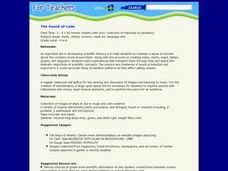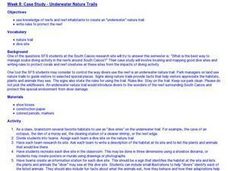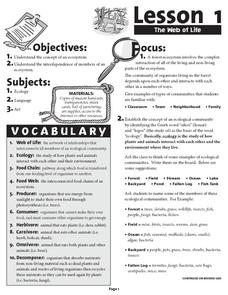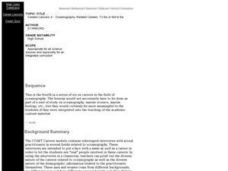Curated OER
Geography Action! Rivers 2001- Human River
Students create a 'human river' by arranging themselves into a river pattern. Each student selects an article to represent a pollutant such as paper, book, or pencil. Students at the source of the river pass their pollutant on to the...
Curated OER
Still Movement
Students explore constant motion. Using photography equipment and a dark room, students develop photographs that depict motion. Students demonstrate the proper use of photograph equipment.
Curated OER
The Inside Current
Eighth graders explore ocean currents and wind patterns. They discover the concept of systems to show how change in one component of a body of water, causes change in other components in that system. Students describe positive and...
Curated OER
The Sound of Calm
Students examine the relationships that exist between ocean currents, wind and climate. Using those relationships, they discuss how they affect the oceans. They create their own music to represent the sounds of the ocean and share them...
Curated OER
The Maggie B.
Pupils are read the book "The Maggie B.". Using the text, they try to name the locations mentioned. They use a map to name all the oceans and seas and discuss the characteristics of each. They color a map worksheet to keep with them for...
Curated OER
Sea Secrets
Students study the following: For centuries, people have been challenged by the mysteries that lie beneath the blue depths of our ocean planet. Very little was known about the ocean until late in the nineteenth century, although nearly...
Curated OER
Underwater Nature Trails
Students research dive sites on an underwater nature trail that would introduce divers to the wonders of the reef surrounding South Caicos. They then recreate each dive site using shoe box diorama and create an information station at...
Curated OER
Making a Globe
Students examine the mercator projection or nautical chart and observe how global maps do not have the same distance as flat maps. They design handmade globes using the meridians and equator as guides to draw in the land. They paint and...
Curated OER
Come on In- the Water's Fine
Students examine how coastal erosion effects seaside communities. They investigate how people have to make choices when manipulate the physical environment such as when dredging and constructing seawalls in coastal areas. They complete a...
Curated OER
Law of the Sea/ Don't Rock the Boat
Students read Ronald Reagan's December 27, 1988 proclamation about US territorial waters. They discuss its contents to decipher exactly what it means and to complete a worksheet answering questions about the proclamation.
Curated OER
Oceans All Over
Students identify the locations and names of the world's oceans. They draw and label a round piece of fruit and answer discussion questions.
Curated OER
Oceanography
Second graders identify saltwater and freshwater habitats and the resources found in them. They compare and contrast the two habitats and discuss their findings. They discover the resources bodies of water can provide.
Curated OER
The Web of Life
Young scholars participate in a game in which they discover the balance of life in the ocean. They identify different organisms that rely on different types of food. They answer questions to complete the lesson.
Curated OER
Oily Oceans
Students are read a book about oceans. They participate in an experiment discovering the effects of oil on water. They discuss different types of pollution and how they can be prevented.
Curated OER
Density Stratification and Ocean Circulation
Students examine how circulation currents of the ocean. They use a tub of hot and cold water to demonstrate the currents. They discover how salinity and temperature of water affect its movement.
Curated OER
What Do These People Know That I Don't Know?
Students research career areas within the field of oceanography. They read interviews of people who work in these fields and discuss how the fields are similar. They write a paragraph or more telling what career choice sounded most...
Curated OER
Oceanography-Related Careers: To Be or Not to Be. . .
Students investigate various careers in the field of oceanography. They conduct Internet research, record data on a spreadsheet, write a justification to explain why someone should accept a position found online, and write a letter to a...
Curated OER
Identifying Continents and Oceans
Students locate and identify the four major oceans and the seven continents on a world map. They use an unlabeled world map and compass rose to describe relative locations of the continents and oceans.
Curated OER
Michigan Quarter Reverse: A Coin Out of Water
Students examine the Michigan quarter reverse and differentiate between bodies of water. On copies of the quarter reverse, they color the land green and the water blue. After observing photos of water bodies, they complete a worksheet...
Curated OER
All That Glitters...
Learners study that white light (visible light) is comprised of all colors of the spectrum. They study that the quantity of light decreases with increasing depth in the ocean. They study that the quality of light changes with increasing...
Curated OER
Hawaiian Bowl!
Students describe the movement of tectonic plates in the Hawaiian archipelago region. They describe how a combination of hotspot activity and tectonic plate movement could produce the arrangement of seamounts obse
Curated OER
Lights in the Deep
Students describe, compare, and contrast bioluminescence, fluorescence, phosphorescence, and chemiluminescence. They explain the role of three major components of bioluminescent systems. They ex
Curated OER
Currents: Bad for Divers; Good for Corals
High schoolers describe, compare, and contrast major forces that drive ocean currents. They discuss the general effects of topography on current velocity. They discuss how velocity affects the ability
Curated OER
Is There Sewage in My Sample?
Students explore the proximity of the Hudson Shelf Valley and the Hudson Canyon to one of the Nation's most populated areas. They study that from 1987 to 1992, two dumpsites in the Hudson Shelf Valley and Hudson Canyon, one 12 miles

























